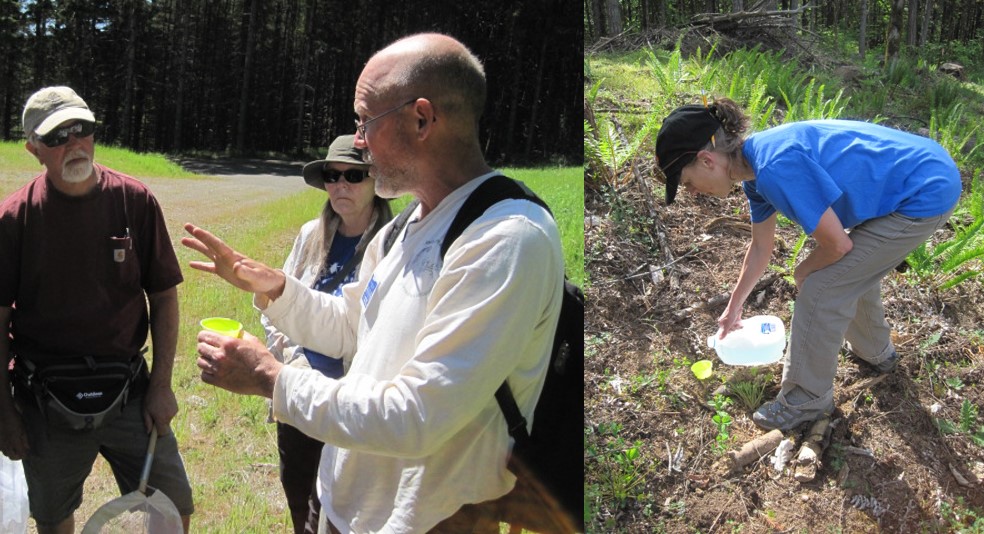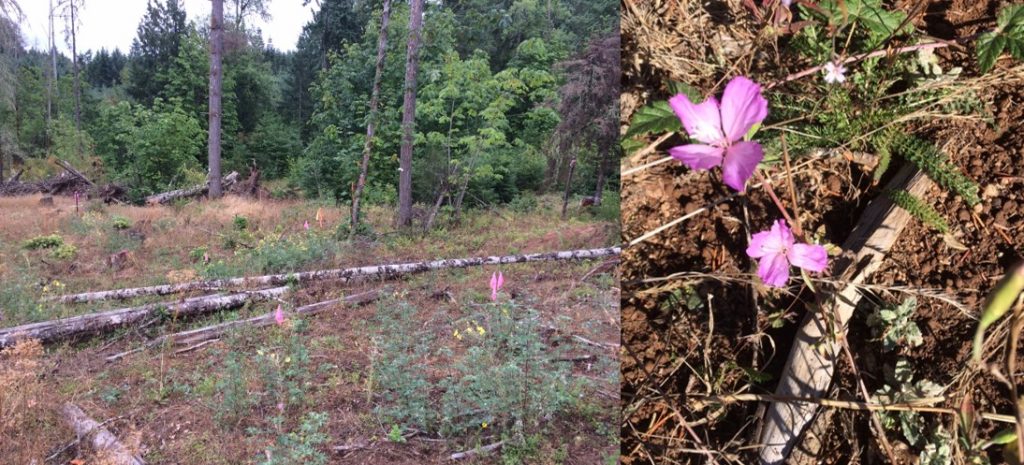By Amy Grotta, OSU Forestry & Natural Resources Extension – Columbia, Washington & Yamhill Counties

Back in February I introduced readers to a new initiative that OSU Extension has begun to learn more about how native bees use managed forests. Our first season of data collection is now in the books. I’d like to explain a bit more about how we designed this project and some early takeaways.
At the Matteson Demonstration Forest, I set up three collection sites. The first site is around the parking area just inside the Matteson gate. It’s the most disturbed of all the sites. We’ll be planting a pollinator hedgerow at this site soon. The other two sites are located in 5-acre units that were clearcut in summer 2018. Because these sites are quite open (in the early seral stage), we expect them to have abundant floral resources that would attract bees. In addition to what plants came into these areas naturally, in one of the sites I scattered native wildflower seed in a strip plot. We would like to see whether this additional influx of floral resources is beneficial to bee populations.
I visited the sites monthly with volunteers from the Oregon Bee Atlas. We collected bees using a combination of methods, and information about each one is recorded in a database. When we used nets to catch bees, we also recorded the plant species we caught them on. But we also used traps filled with soapy water to supplement our netted collections.

So what did we find? Well, we found lots of bees of many different types! While we won’t know how many bee species we collected until they are all reviewed by experts at OSU, it is clear that this forest is home to many native bees. In the spring, we caught an abundance of mining bees in the Andrena genus. These bees nest in bare ground, and in April the soil in the clearcut sites were full of small holes, presumably mining bee nests. We also found red cuckoo bees in the Nomada genus. These bees don’t make their own nests, but lay their eggs in Andrena nests! As the season progressed we found lots of bumblebees, longhorn bees, and beautiful, metallic green small carpenter bees. Carpenter bees nest inside dead wood or old broken off stems, so finding them in a forest seems logical.

At all three sites, non-native weedy plant species were abundant and consequently, we found nearly twice as many bees visiting non-native plants (~150) compared to natives (~80). Here’s a full list of the plants we caught bees on:
| Native plants | Non-native plants |
| Candy flower (Claytonia sibirica) | Bull thistle (Cirsium vulgare) |
| Ocean spray (Holodiscus discolor) | Shiny geranium (Geranium lucidum) |
| Trailing blackberry (Rubus ursinus) | Cat’s ear (Hypochaeris radicata) |
| Oregon iris (Iris tenax) | Oxeye daisy (Leucanthemum vulgare) |
| Licorice root (Ligusticum apifolium) | Meadow knapweed (Centaurea pratensis) |
| Camas (Camassia sp.) | Common vetch (Vicia sativa) |
| Creeping snowberry (Symphoricarpus mollis) | Nipplewort (Lapsana communis) |
| Yarrow (Achillea millefolium) | Hairy vetch (Vicia villosa) |
| Miner’s lettuce (Claytonia perfoliata) | Canada thistle (Cirsium arvense) |
| Self-heal (Prunella vulgaris) | Armenian blackberry (Rubus armeniacus) |
| Farewell-to-spring (Clarkia amoena) | St. Johns Wort (Hypericum perforatum) |
| Common madia (Madia elegans) |
We also caught all kinds of bees in the bowl traps, but in particular there were dozens – perhaps hundreds – of small bees. These can be more difficult to observe and catch with nets, so although we don’t know what plants these small bees were associated with, by using the traps we do know they are inhabiting the site.

The native seed mix that I sowed at one of the sites germinated well, and some of the species even flowered this first year. It takes time for the population to establish so I expect that next year the flowers will be more abundant. We didn’t find many bees visiting these plants – likely because the bees focused their energy on other plants outside the seeded plot which were much more abundant. The exception was on my final collection trip in mid-September, the last really warm day before all this rain hit. By then, the only flowers to be found at the site were in the seeded plot. All the other plants at the site were done for the year, and the clearcut was a sea of brown, dried up stalks. However, the seeded plot was still green. I found bees visiting the lone yarrow, farewell-to-spring, and madia flowers still left.

We’ll be monitoring the sites at Matteson again next year, and I’m looking forward to seeing whether any of these dynamics change. Will we find more bees visiting the native flowers that I seeded in as they become more established? Will there be as many weedy plants for bees to forage on in the clearcuts, now that they have been treated with herbicide in preparation for replanting this winter?
If you are a woodland owner who would like to learn how to provide habitat for native bees on your own property, you’re in luck. Next year, OSU Extension will be offering workshops in various locations on this subject.
If you’d like to get involved with our pollinator sampling at Matteson, and/or on your own property, you can become an Oregon Bee Atlas volunteer. Look for new training opportunities to be announced soon.
Finally, we’ll be planting our demonstration pollinator hedgerow at Matteson at a work-and-learn event on Saturday, November 2nd. All are invited!
Thanks to all of the Oregon Bee Atlas volunteers who enthusiastically helped me survey at Matteson, and to the Oregon Department of Forestry for providing the funds to set up this project (and a similar one in Lane County).

Hi Amy,
very interesting study. I understand how bees pollinate and how they make honey, but am not aware of how they interact with conifer tree flowers. More on that would be useful and maybe even help recruit volunteers to your project.
Hi Gary, thanks for reading. Conifers are wind-pollinated, so their flowers are not all that attractive to bees or other pollen-collecting insects. Probably the bees in the forest are unintentionally collecting conifer pollen that’s suspended in the air, and they carry it back to their nests along with all the other pollen they collect.